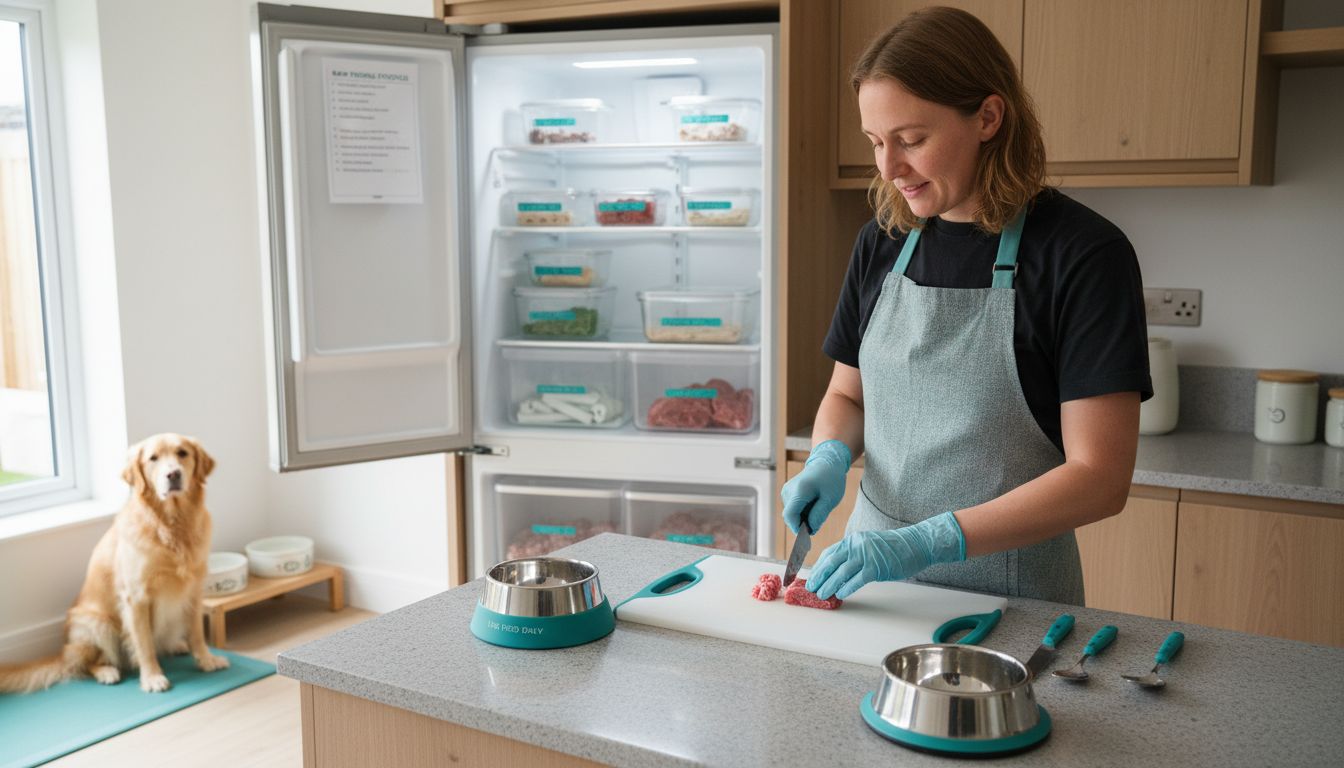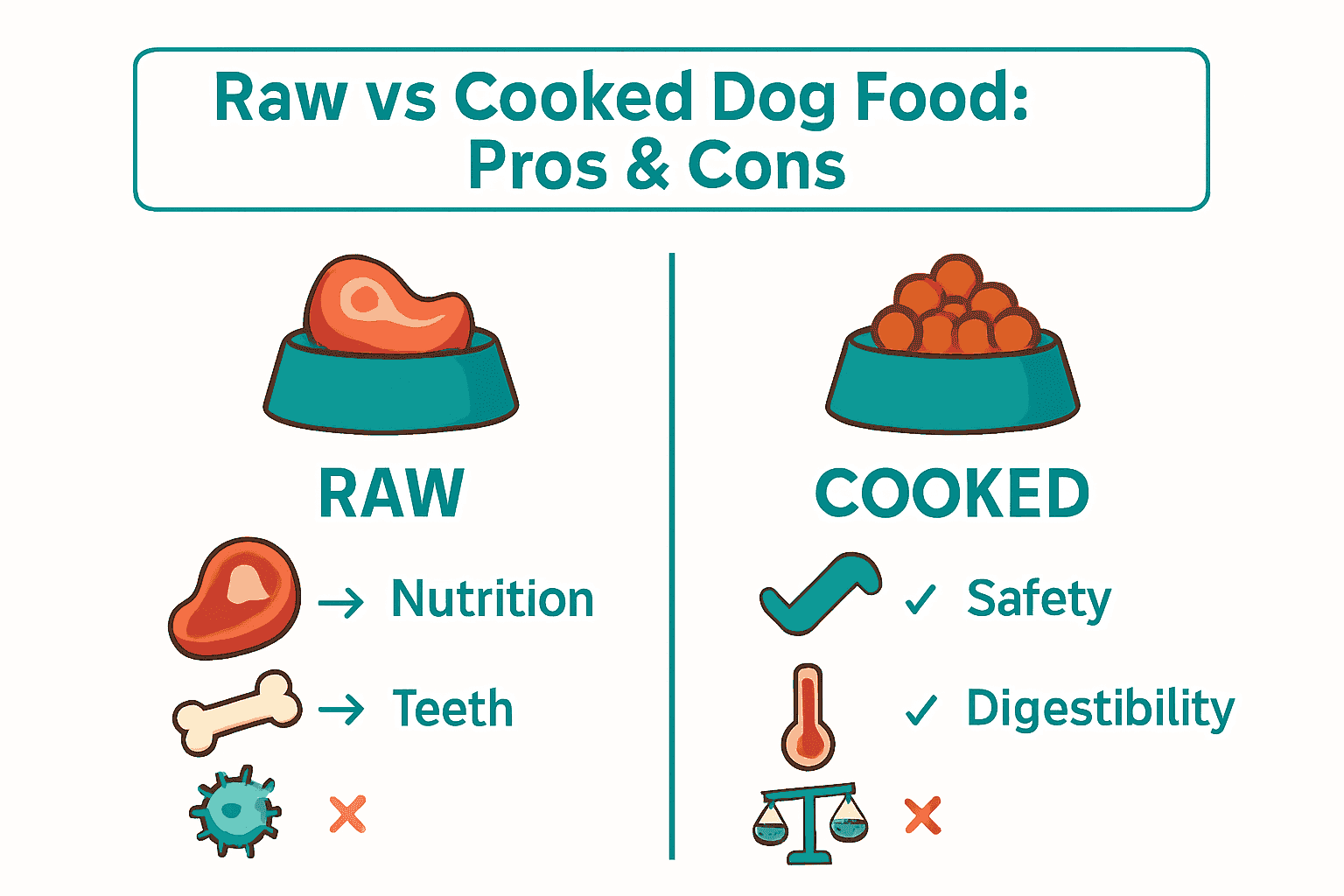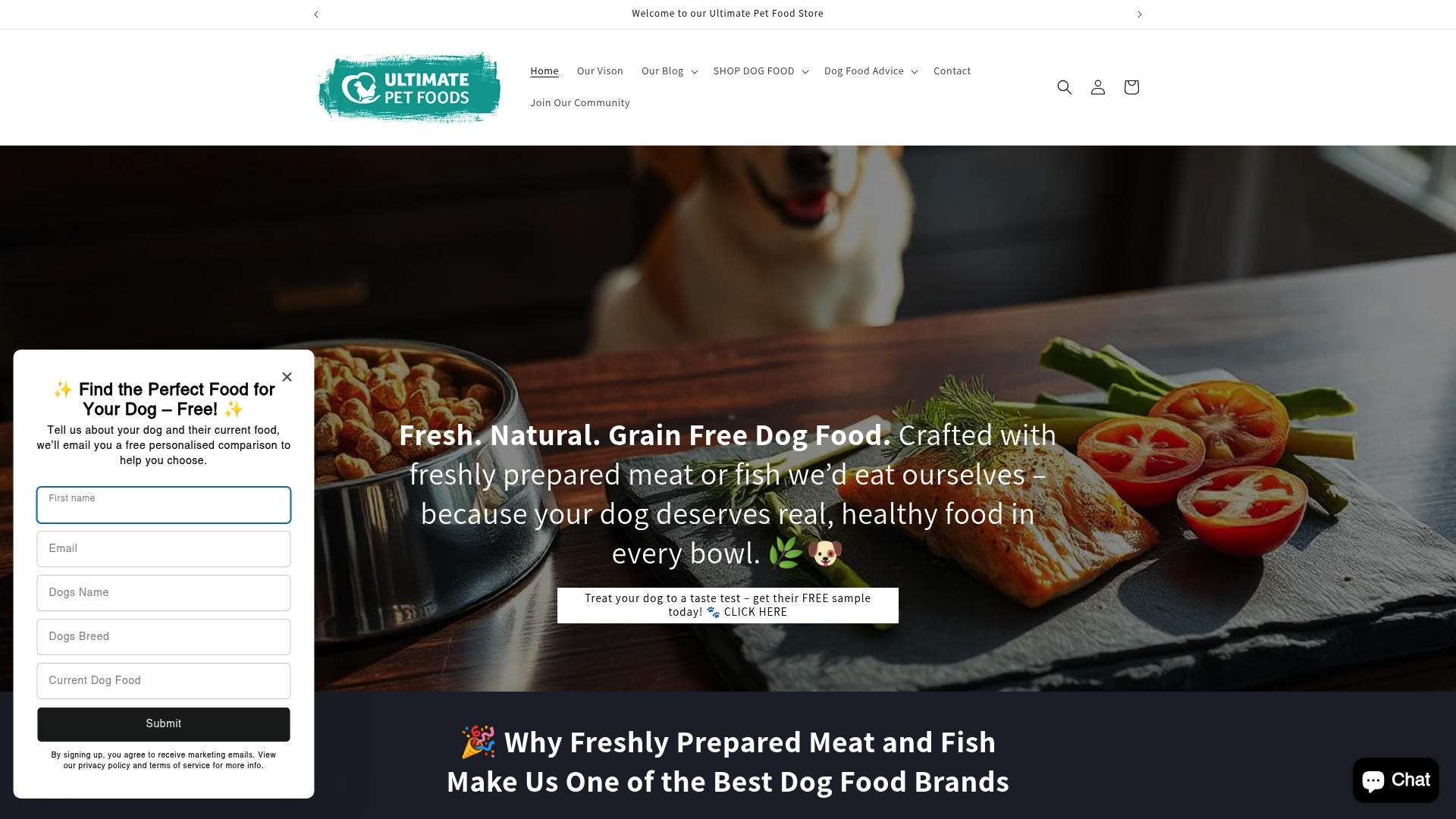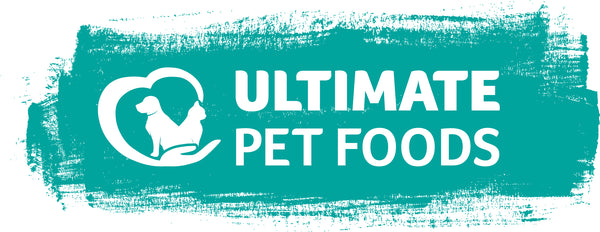
Raw vs Cooked Dog Food: Complete Expert UK Guide
Share
More than 40 percent of dog owners say they feel confused about what’s best for their pet’s diet. The choice between raw and cooked dog food can shape your dog’s long-term health, from their digestion to their coat quality. Knowing the difference between these diets gives you the confidence to pick meals that truly support your furry friend’s wellbeing.
Table of Contents
- Defining Raw Versus Cooked Dog Food
- Types And Variations Of Raw And Cooked Diets
- Safety Risks And Hygiene Requirements
- Nutritional Completeness And Balance Challenges
- Benefits And Drawbacks Of Each Diet
- Practical Feeding Tips And Alternatives
Key Takeaways
| Point | Details |
|---|---|
| Raw vs. Cooked Diets | Raw diets consist of uncooked ingredients mimicking ancestral eating patterns, while cooked diets are processed for safety and convenience. |
| Safety and Hygiene | Raw diets carry higher risks of bacterial contamination; strict hygiene practices are essential when managing raw feeding. |
| Nutritional Balance | Raw diets can lead to nutritional deficiencies without proper formulation, while cooked diets typically offer standardized nutritional profiles. |
| Consult Professional Guidance | Veterinary consultation is crucial for selecting the appropriate diet based on a dog’s individual health needs and nutritional requirements. |
Defining Raw Versus Cooked Dog Food
Understanding the fundamental differences between raw and cooked dog food is crucial for pet owners seeking optimal nutrition for their furry companions. According to PetPlan, raw dog food diets consist of uncooked meat, offal, bones, and sometimes fruits and vegetables, aiming to mimic a dog’s ancestral eating patterns. This approach seeks to replicate the natural dietary habits of dogs’ wild ancestors.
In contrast, cooked dog food represents a more processed nutritional approach. As PDSA explains, these diets typically include commercially prepared kibble or canned food that has undergone careful cooking processes. The primary objectives of cooking are to eliminate potential pathogens and extend the food’s shelf life, providing a safer and more convenient feeding option for modern pet owners.
The core distinctions between raw and cooked dog food extend beyond mere preparation methods. Raw diets emphasise whole, unprocessed ingredients intended to provide nutrients in their most natural state. Cooked diets, however, often involve carefully balanced nutritional formulations that undergo scientific development to ensure complete dietary requirements are met. Our guide to real meat dog food provides deeper insights into how different preparation methods can impact nutritional value.
Key differences between raw and cooked dog food include:
- Preparation method: Uncooked vs heat-processed
- Pathogen risk: Higher in raw diets, lower in cooked diets
- Nutritional preservation: Raw potentially retains more enzymes, cooked ensures protein digestibility
- Convenience: Cooked foods are typically easier to store and serve
Choosing between raw and cooked dog food depends on multiple factors including your dog’s specific health needs, age, breed, and individual digestive capabilities. Consulting with a veterinary nutritionist can help determine the most appropriate dietary approach for your specific canine companion.
Types And Variations Of Raw And Cooked Diets
Dog nutrition encompasses a fascinating array of dietary approaches, each with unique characteristics and potential benefits. According to Houndsy, raw diets include several compelling variations, with the BARF (Biologically Appropriate Raw Food) diet standing out as a prominent example. This approach typically consists of raw meat, uncooked bones, and fresh vegetables, designed to closely mimic a dog’s ancestral eating patterns.
Cooked diets present a broader spectrum of nutritional options. These include dry kibble, wet canned food, and carefully prepared home-cooked meals, each offering distinct nutritional profiles and preparation methods. Our guide to understanding raw vs kibble dog food provides deeper insights into the nuanced differences between these dietary approaches.
Within raw diet variations, pet owners can explore multiple approaches:
- BARF Diet: Raw meat, bones, and vegetables
- Prey Model Raw: Mimicking whole prey consumption
- Supplemented Raw: Adding vitamins and minerals to raw ingredients
Cooked diet variations similarly offer diverse options:
- Dry Kibble: Convenient, shelf-stable nutrition
- Wet Canned Food: Higher moisture content
- Home-Cooked Meals: Customised nutrition with complete control
Ultimately, selecting the right diet depends on your dog’s individual health requirements, age, breed, and specific nutritional needs. Consulting with a veterinary nutritionist can help determine the most appropriate dietary strategy for your canine companion.
Safety Risks And Hygiene Requirements
When considering raw dog food diets, understanding potential safety risks is paramount for responsible pet owners. According to the British Veterinary Association, raw meat diets can harbor dangerous pathogenic bacteria such as E. coli, Salmonella, and Listeria, presenting significant health risks to both dogs and their human companions.
Properly mitigating these risks requires meticulous hygiene practices. PDSA recommends opting for commercially prepared raw diets that meet rigorous safety standards to ensure nutritional adequacy and minimise potential health complications. Our guide to transitioning dog foods provides additional insights into safe dietary transitions.
Critical hygiene protocols for raw feeding include:
- Separate food preparation surfaces
- Thorough cleaning of utensils and bowls
- Immediate refrigeration of unused portions
- Regular hand washing
- Sanitising food storage areas
Key safety considerations for raw diets:
- Bacterial contamination risks
- Potential nutritional imbalances
- Need for careful portion and ingredient management
- Regular veterinary monitoring
Ultimately, pet owners must carefully weigh the potential benefits against the inherent risks, always prioritising their dog’s health and well-being through informed, responsible feeding practices.

Nutritional Completeness And Balance Challenges
Navigating the complex world of dog nutrition requires careful consideration of dietary balance and nutritional requirements. According to PetPlan, ensuring a balanced diet can be particularly challenging with raw feeding approaches, as improper formulation may lead to significant nutritional deficiencies. Commercially prepared cooked diets typically offer more standardised nutritional profiles that meet established dietary guidelines.
PDSA emphasises the critical importance of professional guidance, recommending that dog owners consult veterinarians to ensure any diet—whether raw or cooked—meets comprehensive nutritional requirements. Our guide to understanding holistic dog nutrition provides additional insights into creating balanced nutrition for canine companions.
Key nutritional challenges in raw and homemade diets include:
- Potential protein imbalances
- Risk of mineral and vitamin deficiencies
- Inconsistent macronutrient ratios
- Difficulty achieving complete amino acid profiles
- Potential calcium-phosphorus ratio complications
Strategies for ensuring nutritional balance:
- Consult veterinary nutritionists
- Use precise ingredient measurements
- Incorporate comprehensive vitamin and mineral supplements
- Regularly monitor your dog’s health and weight
- Conduct periodic blood work to assess nutritional status
Ultimately, successful dog nutrition demands a personalised approach that considers individual health needs, breed characteristics, age, and activity levels. Professional guidance remains the most reliable path to optimal canine dietary health.
Benefits And Drawbacks Of Each Diet
Dog nutrition is a nuanced landscape of choices, with each dietary approach presenting unique advantages and challenges. According to PetPlan, raw diets can offer compelling benefits like improved coat condition and enhanced dental health, while simultaneously carrying significant risks such as potential bacterial contamination and nutritional imbalances.
PDSA highlights the complex trade-offs between raw and cooked feeding strategies. Our guide to understanding dog foods to avoid provides additional context for making informed nutritional decisions.
Benefits of Raw Diets:
- Potentially improved coat shine
- Natural dental cleaning
- Minimally processed ingredients
- Higher moisture content
- Closer to ancestral eating patterns
Drawbacks of Raw Diets:
- Higher bacterial contamination risks
- Complex nutritional balancing
- Increased preparation time
- Potential digestive challenges
- Higher cost
Benefits of Cooked Diets:
- Consistent nutritional profiles
- Reduced pathogen risks
- Convenient preparation
- Extended shelf life
- Scientifically formulated
Drawbacks of Cooked Diets:
- Potential nutrient degradation
- Possible additive presence
- Less moisture
- Reduced enzymatic activity
Choosing between raw and cooked diets requires careful consideration of your individual dog’s health, age, breed, and specific nutritional requirements.

Practical Feeding Tips And Alternatives
Navigating the complexities of dog nutrition requires careful consideration and strategic planning. According to PDSA, when exploring dietary options, it’s crucial to consult with a veterinarian and prioritise safety and nutritional adequacy, particularly when considering raw feeding approaches.
PetPlan emphasises the importance of proper hygiene and varied nutritional strategies. Our dog food portion control guide provides additional insights into managing your dog’s nutritional intake effectively.
Practical Feeding Strategies:
- Gradually introduce dietary changes
- Monitor weight and body condition
- Rotate protein sources
- Use high-quality, minimally processed ingredients
- Consider age and activity level specific nutrition
Hygiene and Safety Protocols:
- Separate food preparation areas
- Use clean utensils and bowls
- Store food at appropriate temperatures
- Wash hands thoroughly after handling
- Regularly clean feeding areas
Alternative Feeding Approaches:
- Hybrid feeding (mix of raw and cooked)
- Commercially prepared balanced raw diets
- Home-cooked meals under veterinary guidance
- Rotation of different high-quality commercial foods
Ultimately, successful dog nutrition requires a personalised approach that considers your individual dog’s unique health requirements, breed characteristics, and lifestyle factors.
Find the Perfect Balance Between Raw and Cooked Nutrition for Your Dog
Choosing between raw and cooked dog food can feel overwhelming when you want the very best for your dog’s health. This guide highlights common concerns such as nutritional balance, hygiene risks, and tailored feeding strategies that every responsible pet owner should consider. If you seek a safe, natural, and nutritionally complete alternative that simplifies mealtime while supporting your dog’s specific needs, you are not alone.
Explore our range of premium Dry Dog Food | Grain-Free & Science-Backed Kibble created to deliver carefully crafted nutrition without compromising on natural ingredients.

Take control of your dog’s wellbeing today by visiting Ultimate Pet Foods and discover products that combine safety, quality, and dietary expertise in every meal. For puppies just starting out, our specialised Grain Free Puppy Food options ensure optimal growth and digestive health. Support your dog’s happiness and vitality now by making informed food choices that reduce risk and enhance natural benefits.
Frequently Asked Questions
What are the main differences between raw and cooked dog food?
Raw dog food consists of uncooked meat, offal, bones, and sometimes fruits and vegetables, while cooked dog food includes heat-processed kibble or canned food. Raw diets focus on whole, unprocessed ingredients, whereas cooked diets are formulated to meet specific nutritional guidelines and reduce pathogen risks.
What are the safety risks associated with raw dog food?
Raw dog food can harbor dangerous bacteria like E. coli, Salmonella, and Listeria, which pose health risks to both dogs and humans. To mitigate these risks, it’s essential to follow strict hygiene practices during preparation and choose commercially prepared raw diets that meet safety standards.
How can I ensure my dog’s diet is nutritionally balanced?
Consulting with a veterinary nutritionist is crucial for ensuring a balanced diet, especially when feeding raw or home-cooked meals. It’s important to use precise ingredient measurements and consider vitamin and mineral supplements to meet comprehensive nutritional requirements.
What are the benefits and drawbacks of feeding my dog a raw diet?
Benefits of raw diets include improved coat condition and natural dental cleaning due to the raw ingredients. Drawbacks include higher risks of bacterial contamination and potential nutritional imbalances. It’s important to weigh these pros and cons against your dog’s specific health needs.
